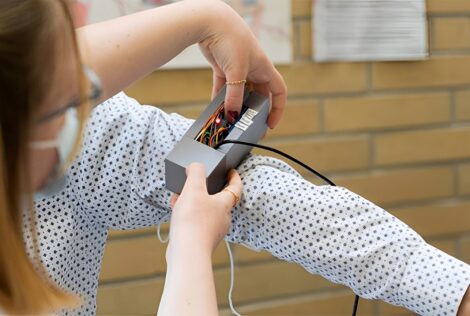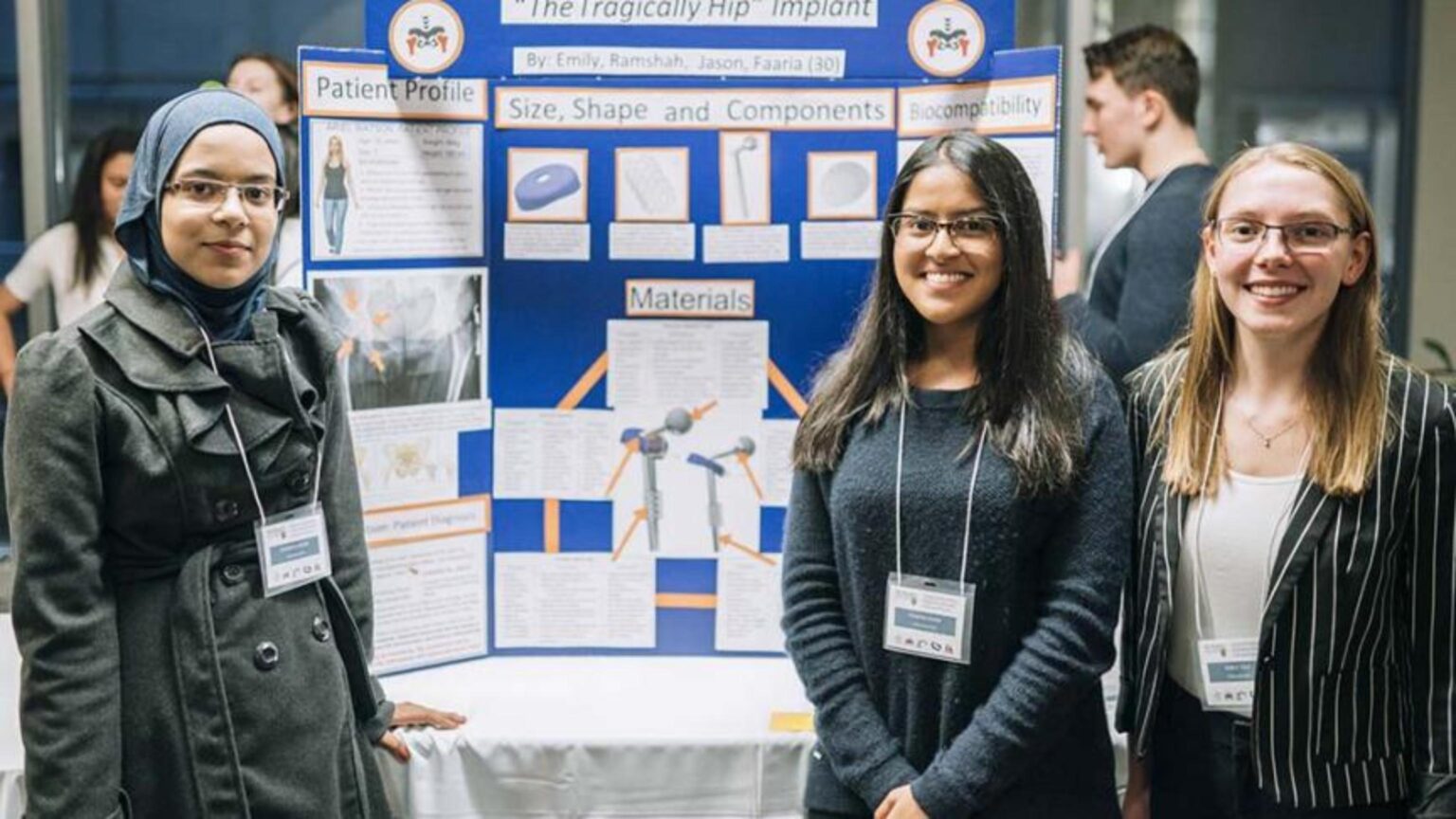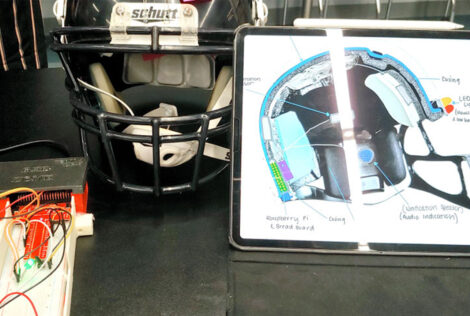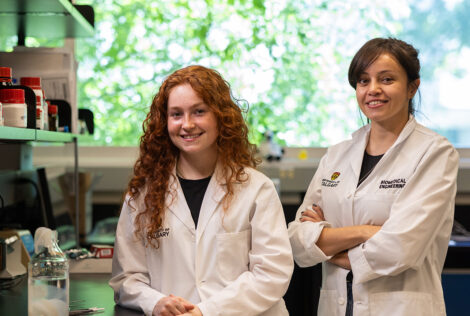

Spider silk meshing that encourages bone regrowth. Silicon carbide that transmits stress signals to a physician. Ultra-high molecular-weight polyethylene that is strong, yet ductile.
These are just some of the biomaterials first year Integrated Biomedical Engineering & Health Sciences (iBioMed) students used for their innovative hip implant designs, presented at a Fall Showcase Poster Presentation on November 1.
This was the first of five major projects undertaken by 32 teams of students in the new combined program that began this past September.
The project was part of a series of design challenges students will work on throughout the year as part of the 1P10 Health Solutions Design Projects 1 course. As the year progresses, projects will increase in complexity, culminating with a real-world problem students will solve using design solutions that meet the needs of their peers who are registered with McMaster’s Student Accessibility Services (SAS). The solution, whether is a device, piece of software or a process, would make a certain aspect of their daily life easier.
For the hip implant project, students were given patient profiles created by the program’s development team. They worked with healthcare professionals and residents from Hamilton Health Sciences to diagnose the condition of the patient, using clues from the patient’s history and x-ray images. Students were given guidelines to be creative and think outside of the box, rather than go with the commercial ‘off-the-shelf’ implants.
“Throughout the course, we gave students the foundational skills to implement biomedical engineering solutions to this problem,” explains Colin McDonald, Assistant Professor, Department of Mechanical Engineering and co-instructor of the course. “Students went above and beyond. They sought both the medical literature and faculty outside the course to integrate biomedical engineering solutions with innovative medicinal solutions.”
Meet three teams who presented their innovative hip implant designs at the Poster Showcase:
Names (L to R): Ramsha Nasir, Faaria Khan and Emily Yeo
Patient Profile: Ariel, an active young woman who feels a popping sensation and pain in her right hip.
The “Tragically Hip” Implant: Faaria: “There is bone on bone contact happening in her hip. We recommended an osteotomy [a surgical operation where the bone is cut to change its alignment.] A small incision would be made in her femur and we would use a piece of her femur to round out her acetabulum. Our implant not only treats the incision site, it is also correcting the worn features of bone on bone contact with the femur head.”
Coolest design component: Faaria: “We have a spider silk mesh that wraps around the femur. The material has antimicrobial properties which fight any antibacterial infections that might occur after the operation. It is also biodegradable so there would be no surgery to remove it. It simply disintegrates into the body.”
Most rewarding part about the experience: Emily: “Having a patient and diagnosing what the problem was and from there, creating something unique for that patient. I’ve never done anything like that before.”
Names (L to R): Sarah Rassenberg, Eric Hillebrand and Jan Wolos
Patient Profile: Art, an older man who has had two hip dislocations and worked as an RN for most of his life which put more stress on his hip. He is allergic to metallic materials.
The Artistic Hip: Jan: “The patient had osteoarthritis in his left hip so we recommended a left hip replacement. The most common hip implants are made from metals. Since our patient is allergic to this material, we looked at something completely different. We focused on using ultra-high molecular polyethylene, a material with more ductility to prevent any shattering in case the patient experiences a fall.”
Coolest design component: Sarah: “Silicon carbide was also used for the implant. This material is conductive so it can transmit signals. So you can put a biomedical device on it, which could let doctors know for example, if the patient’s immune system is down.”
Most rewarding part about the experience: Eric: “We used an awesome software for the design process and we all had the opportunity to design one part. When we brought it all together to assemble it, it was incredible.”
Names (L to R): Jeffrey Suitor, Akansha Prasad, Maya Ziolkowska
Patient Profile: Jason is 54 years old, overweight and inactive. He had a previous implant and is experiencing pain.
Hip Hop Hooray: Maya: “Our plan would be to take out his previous hip implant, insert a new one and have a post-op treatment that includes stem cell injections and an exercise plan.”
Jeffrey: “We needed to find a lifelong solution due to his previous hip implant complications. We decided to replace the top of the femur with a meshing and regrow his bone from the base up, eventually giving him a lifelong solution.”
Coolest design component: Akansha: “Taking spider silk to encourage bone regrowth. This is something that’s revolutionary.”
Most rewarding part about the experience: Maya: “We went into such depth with the materials. I didn’t think about materials on such a complex level before. That was really interesting to me.”
Jeffrey: “I found a lot of the philosophy, in regards to new treatment methods very interesting – from less invasive surgeries to more of a focus on regenerative properties and getting patients out the hospital faster.”


